Carpet Cost Estimator
Carpet flooring is a popular choice for both residential and commercial spaces due to its comfort, warmth, and versatility. Available in a wide range of colors, textures, and patterns, carpet can enhance the aesthetic appeal of any room while providing sound insulation and a soft surface underfoot. However, accurate cost estimation is essential to ensure that your carpet installation project stays within budget and meets all design and functional requirements. Estimate Florida Consulting provides expert cost estimator services to help you plan and execute your carpet installation with precision and efficiency.
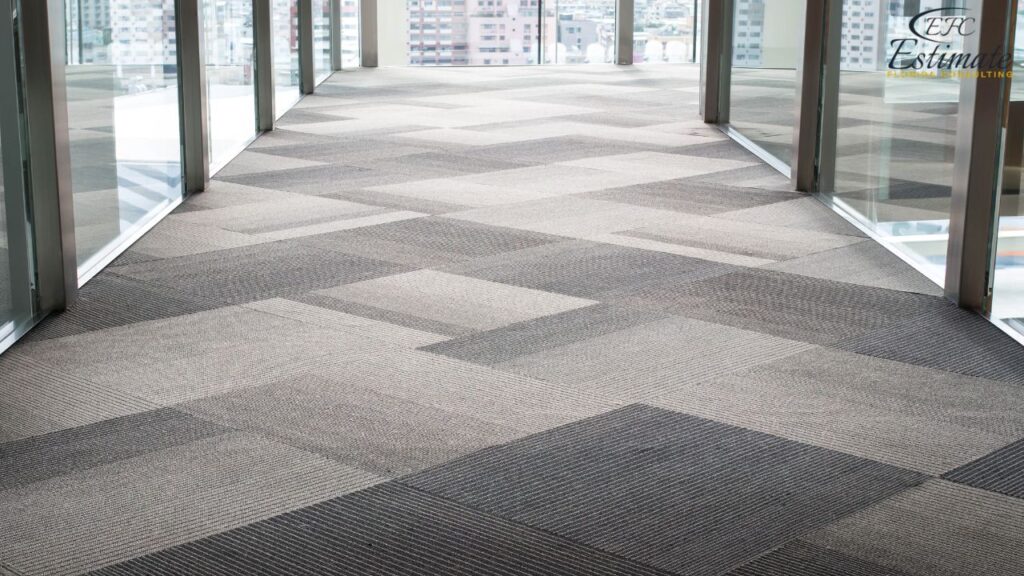
Why Carpet Costs Vary: Key Factors to Consider
When embarking on a carpet installation project, it’s important to recognize that several factors can influence the overall cost. These factors include the type of carpet material, the style of the carpet, the quality of the padding used, and the complexity of the installation process. Each of these elements plays a significant role in determining the final price of your carpet project. By understanding these variables, you can make decisions that align with your budget while achieving the desired aesthetic and functional outcomes for your space. This comprehensive understanding will enable you to plan effectively and ensure that your project stays within budget.
Choosing the Right Carpet Material: Impact on Cost
The material of the carpet is one of the most significant determinants of cost. Carpets are made from a variety of fibers, each offering distinct benefits, durability levels, and price points. The type of material you choose will have a substantial impact on both the initial cost and the long-term value of your carpet. For instance, nylon carpets are well-regarded for their exceptional durability and resistance to stains, making them an ideal choice for high-traffic areas. In contrast, wool carpets offer unparalleled luxury and comfort, though they come at a higher price point and require more maintenance. Understanding the characteristics of each material will help you make an informed decision that balances cost with quality, ensuring that your carpet meets your specific needs and preferences.
Carpet Material | Average Cost per Sq.Ft. |
Nylon | $3.00 – $7.00 |
Polyester | $2.00 – $5.00 |
Wool | $5.00 – $15.00 |
Olefin (Polypropylene) | $1.50 – $3.50 |
Triexta | $3.50 – $8.00 |
Nylon Carpets:
Nylon is widely recognized for its exceptional durability and stain resistance, making it a top choice for high-traffic areas such as hallways, living rooms, and commercial spaces. Its resilience ensures that it can withstand significant foot traffic without showing signs of wear and tear, making it a smart long-term investment despite its higher cost. Additionally, nylon carpets are available in a wide range of colors and styles, allowing you to choose a look that complements your interior design while benefiting from the practical advantages of this durable material.
Polyester Carpets:
Polyester is known for its soft texture and vibrant color options, making it an attractive choice for residential spaces like bedrooms and family rooms. It is typically more affordable than nylon, offering a cost-effective solution for those looking to add a touch of luxury without overspending. While polyester may not be as durable as nylon, it excels in providing comfort underfoot, making it a great option for areas with lighter foot traffic. Its affordability, combined with its aesthetic appeal, makes polyester a popular choice for homeowners seeking a balance between cost and comfort.
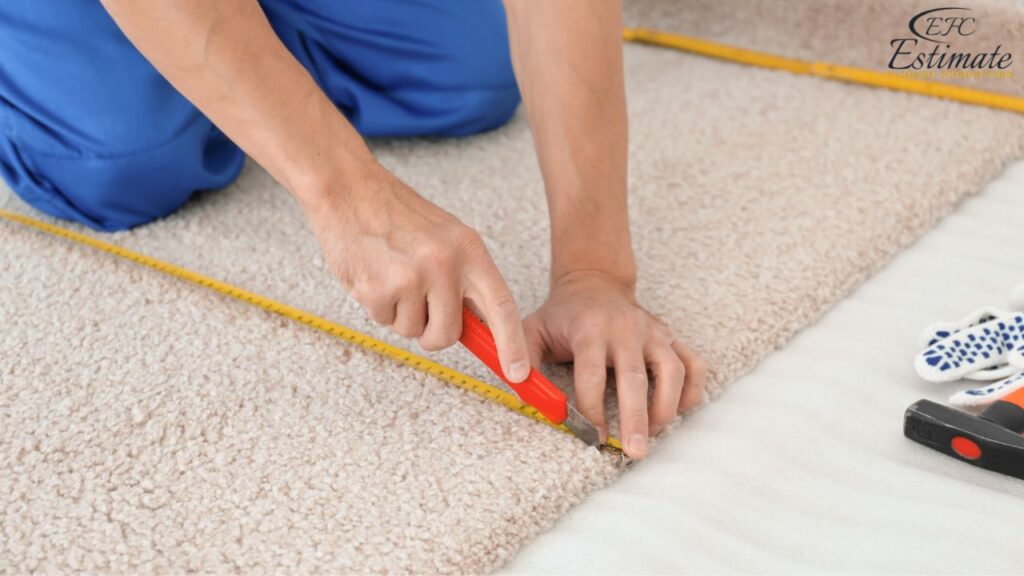
Wool Carpets:
Wool is a natural fiber that exudes luxury, warmth, and comfort, making it an excellent choice for formal living rooms, master bedrooms, and other spaces where elegance is desired. Wool carpets are highly durable and naturally resistant to dirt and stains, though they do require more maintenance to keep them looking their best. The investment in wool can be justified by its long lifespan and the sophisticated aesthetic it brings to any space. Additionally, wool’s natural insulating properties make it an energy-efficient option, helping to regulate temperature and reduce energy costs.
Olefin (Polypropylene) Carpets:
Olefin is a synthetic fiber known for its moisture resistance and affordability, making it a suitable option for basements, outdoor areas, and commercial spaces where durability is paramount. Although it is less soft than other materials, its ability to resist moisture and stains makes it ideal for areas prone to spills or dampness. Olefin is also resistant to fading, making it a good choice for spaces with significant sunlight exposure. Its lower cost and practical benefits make it a popular choice for functional, high-usage areas where budget constraints are a consideration.
Triexta Carpets:
Triexta is a newer material that combines the durability of nylon with enhanced softness, making it a versatile option for both residential and commercial settings. This fiber is known for its stain resistance and comfort, making it ideal for homes with children and pets. Triexta offers a good balance between cost, durability, and comfort, making it an excellent all-around choice for various applications. Its ability to retain its appearance over time, even in high-traffic areas, makes it a strong contender for those seeking a long-lasting carpet that doesn’t compromise on softness or style.
Carpet Styles: How Design Impacts Price
The style of carpet you choose will significantly influence not only the overall cost but also the aesthetic appeal and functionality of the space. Different carpet styles offer varying levels of comfort, durability, and visual interest, so it’s important to choose a style that aligns with your design goals and the specific needs of the room. For instance, cut pile carpets provide a soft, luxurious feel that is perfect for bedrooms, while loop pile carpets are highly durable and better suited for high-traffic areas such as offices or hallways. Understanding the different styles available and their respective benefits will help you make a well-informed decision that enhances both the look and usability of your space.
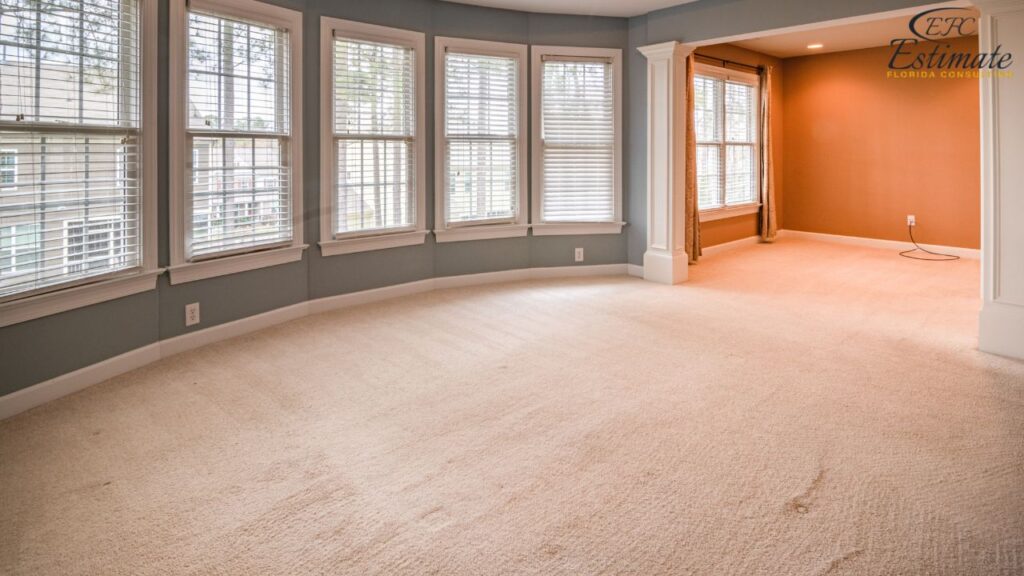
Carpet Style | Average Cost per Sq.Ft. |
Cut Pile | $2.50 – $6.00 |
Loop Pile | $3.00 – $7.50 |
Cut and Loop | $4.00 – $8.00 |
Berber | $2.50 – $5.50 |
Saxony | $3.50 – $8.00 |
Cut Pile Carpets:
Cut pile carpets are characterized by fibers that are cut at the ends, creating a soft, smooth surface that is both luxurious and versatile. This style is available in various textures, ranging from plush to shag, and is suitable for most residential spaces, including bedrooms, living rooms, and home offices. The softness of cut pile carpets provides a comfortable underfoot experience, making them a popular choice for areas where comfort is a priority. Additionally, the range of available textures allows homeowners to choose a style that best matches their interior design, whether they are looking for something modern, traditional, or somewhere in between.
Loop Pile Carpets:
Loop pile carpets are made from uncut loops of yarn, offering durability and resistance to crushing. This style is particularly well-suited for high-traffic areas such as hallways, offices, and entryways, where durability is a key concern. The tight loops in loop pile carpets help maintain their shape and appearance even under heavy use, making them a practical choice for busy environments. Loop pile carpets are also easier to clean and maintain, as their dense construction makes it harder for dirt and debris to penetrate the surface. This makes them an ideal choice for commercial spaces or homes with pets and children.
Cut and Loop Carpets:
Cut and loop carpets combine cut and looped fibers to create a patterned appearance that adds visual interest and texture to any room. This style is perfect for those looking to make a statement with their flooring, as the combination of textures allows for unique patterns that can enhance the design of any room. The varied texture also helps to hide footprints and vacuum marks, making it a low-maintenance option for busy households. Whether you’re looking to create a bold statement or a subtle pattern, cut and loop carpets offer a versatile solution that can elevate the aesthetic of your space while providing durability.
Berber Carpets:
Berber carpets feature thick, looped fibers that provide a casual, textured look, making them a popular choice for family rooms, basements, and other informal spaces. Known for their durability, Berber carpets can withstand heavy use and are less likely to show wear and tear over time. The dense loops in Berber carpets help hide dirt and footprints, making them an excellent option for households with kids or pets. Additionally, Berber’s unique texture adds a tactile dimension to a room, creating a warm and inviting atmosphere. While Berber carpets are often associated with a more casual look, they are available in a variety of colors and patterns, allowing them to fit into a range of design styles.
Saxony Carpets:
Saxony carpets have a plush, smooth finish that feels luxurious underfoot, making them ideal for formal areas like dining rooms, master bedrooms, and living rooms where a soft, elegant appearance is desired. The velvety texture of Saxony carpets gives any room a sophisticated look, making it a perfect choice for spaces where you want to create a sense of luxury and comfort. Saxony carpets are known for their high pile, which adds to their plush feel but also requires more maintenance to keep them looking their best. Regular vacuuming and occasional professional cleaning are recommended to maintain their appearance. Saxony’s luxurious texture makes it a standout choice for those looking to add a touch of opulence to their home.
Roofing Videos
Commercial Roofing
Metal Roof Installation
Roof Installation
Comfort with Carpet Padding: Why It Matters
Carpet padding, also known as underlay, is an essential component that enhances the comfort, insulation, and durability of your carpet. The quality of padding you choose will significantly impact how your carpet feels and performs over time. Good padding can make a substantial difference in the overall comfort of your carpet, providing a softer and more cushioned feel underfoot. Additionally, high-quality padding helps to absorb the impact of foot traffic, extending the life of your carpet by preventing it from wearing out prematurely. Investing in high-quality padding is essential for ensuring that your carpet remains comfortable, durable, and visually appealing for many years.
Padding Type | Average Cost per Sq.Ft. |
Rebond Padding | $0.30 – $0.70 |
Foam Padding | $0.50 – $1.00 |
Rubber Padding | $1.50 – $3.00 |
Memory Foam Padding | $1.00 – $2.50 |
Rebond Padding:
Rebond padding is a popular and affordable choice for residential carpets. Made from recycled foam, it offers a good balance of comfort and durability, making it suitable for most areas of the home. Rebond padding provides sufficient cushioning to make walking on the carpet a pleasant experience, and its environmentally friendly construction appeals to those looking for sustainable options. Despite its lower cost, rebond padding offers reliable performance, helping to extend the life of the carpet by providing a sturdy base that absorbs the impact of foot traffic.
Foam Padding:
Foam padding offers a softer feel underfoot and is available in various thicknesses, making it ideal for bedrooms and areas where extra cushioning is desired. The softness of foam padding makes it particularly appealing for spaces where comfort is a priority, such as children’s rooms or guest bedrooms. Foam padding also provides a level of sound insulation, which can be beneficial in multi-story homes or apartments where noise reduction is important. Its versatility and comfort make it a popular choice for homeowners looking to enhance the feel of their carpet without significantly increasing costs.
Rubber Padding:
Rubber padding is a premium option that provides superior comfort and noise reduction. It is often used in areas where maximum durability and comfort are required, such as home theaters, living rooms, or commercial spaces. Rubber padding is highly durable, offering excellent support and resilience, which helps to maintain the carpet’s appearance over time. Additionally, rubber padding is resistant to moisture, making it a good choice for areas where spills or dampness are a concern. While it is more expensive than other types of padding, the benefits of rubber padding in terms of comfort, durability, and longevity often outweigh the higher cost.
Memory Foam Padding:
Memory foam padding adds an extra layer of luxury to your carpet, providing exceptional comfort and support. It is an excellent choice for areas where you want to maximize comfort, like bedrooms, lounges, or living rooms. The contouring properties of memory foam padding can make standing or walking on the carpet more comfortable, especially for those who spend a lot of time on their feet. Memory foam padding also offers good sound insulation, contributing to a quieter and more peaceful environment. While it is one of the more expensive padding options, its ability to enhance the comfort and longevity of your carpet makes it a worthwhile investment for those looking to create a truly luxurious space.
How Room Size and Layout Affect Carpet Costs?
The size and layout of the room where you plan to install carpet directly impact the total cost of the project. Larger rooms will require more material, which increases both the material and installation costs. Additionally, the shape and complexity of the room can affect how much carpet is needed and how labor-intensive the installation process will be. For example, rooms with irregular shapes, alcoves, or multiple doorways may require additional carpet and more precise cutting, which can increase the overall cost of the installation. Understanding how these factors influence costs will help you budget more effectively and ensure that you allocate enough resources to cover the entire project.
Room Size | Average Cost for Nylon Carpet (Installed) |
100 sq.ft. | $500 – $1,000 |
200 sq.ft. | $1,000 – $2,000 |
300 sq.ft. | $1,500 – $3,000 |
500 sq.ft. | $2,500 – $5,000 |
1,000 sq.ft. | $5,000 – $10,000 |
Simple Rooms:
Rooms with a straightforward layout, such as squares or rectangles, are easier and cheaper to carpet. They require less cutting and fitting, which reduces labor costs. Simple rooms allow for more efficient installation, which can help keep your project within budget while still achieving a high-quality finish. The predictability of a simple room layout also makes it easier to estimate costs accurately, reducing the likelihood of unexpected expenses.
Complex Rooms:
Rooms with irregular shapes, alcoves, or multiple doorways increase the amount of carpet required and the complexity of the installation. This adds to both material and labor costs, as more time and precision are needed to ensure a proper fit. Complex rooms often present unique challenges, such as matching patterns at seams or dealing with uneven subfloors, which can further increase costs. However, with careful planning and the right expertise, even complex installations can be completed successfully, resulting in a beautifully finished space that meets your design and functional goals.
Labor Costs and Installation Complexity: What to Expect
The complexity of your carpet installation will significantly impact labor costs. Simple installations are generally more straightforward and less expensive, while more complex jobs involving stairs, multiple rooms, or custom designs will require more time and expertise, leading to higher labor costs. The more intricate the installation, the greater the need for specialized skills and tools to ensure a professional finish. Additionally, if your project involves removing old carpet, repairing subflooring, or other preparatory work, these tasks will add to the overall cost.
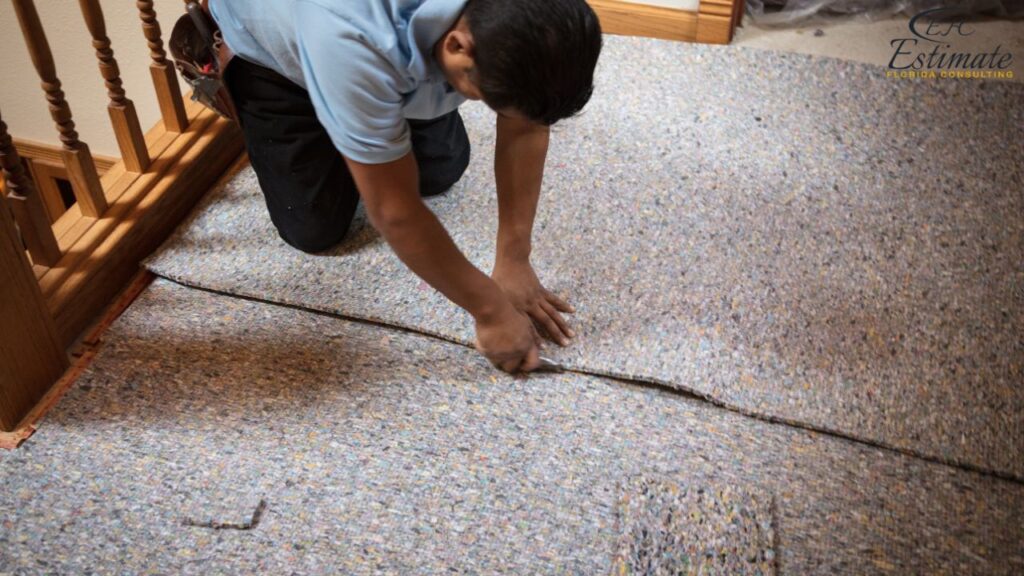
Understanding the specific challenges of your installation can help you budget more accurately and ensure that the work is completed to a high standard, resulting in a durable and aesthetically pleasing carpet that enhances your space.
Installation Type | Labor Cost per Sq.Ft. |
Standard Installation | $1.00 – $2.00 |
Complex Installation | $2.50 – $4.50 |
Standard Installation:
Standard installation is ideal for simple room layouts with minimal seams and straightforward cuts. This type of installation is typically quicker and less labor-intensive, making it a cost-effective option for homeowners looking to minimize expenses while still achieving a high-quality finish. Standard installations are well-suited for spaces like bedrooms, living rooms, and offices where the room layout is straightforward and does not require intricate work. The efficiency of standard installations helps to keep labor costs low, making it an attractive option for those working within a tight budget.
Complex Installation:
Complex installations require custom cuts, handling stairs, or creating intricate patterns, which demand more skill and time, resulting in higher labor costs. These installations may involve additional considerations, such as matching patterns at seams or dealing with uneven subfloors, which can further increase the time and expertise required. Complex installations are often necessary in larger homes with multiple levels, rooms with unusual shapes, or when using patterned carpets that require precise alignment. The additional cost of a complex installation is often justified by the professional, polished finish it provides, ensuring that your carpet looks its best and lasts longer.
Estimating Carpet Costs: A Step-by-Step Guide
To get a clear picture of your carpet installation costs, it’s important to follow a systematic approach. Estimating costs accurately involves considering multiple factors, from the size of the room to the type of carpet material and the complexity of the installation.
By taking a step-by-step approach, you can ensure that all aspects of the project are accounted for, resulting in a comprehensive and realistic budget that guides your decision-making process and helps you avoid unexpected expenses.
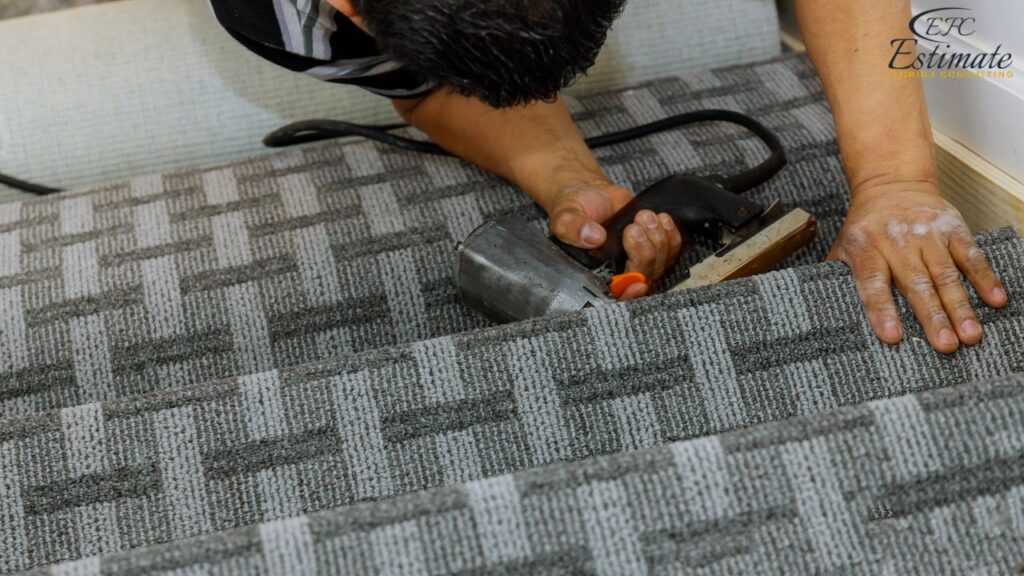
Step 1: Measure Your Space Accurately
Start by measuring the length and width of each room where you plan to install carpet. Multiply these dimensions to calculate the total square footage. For irregularly shaped rooms, break the area into smaller sections and sum the square footage. Accurate measurements are crucial for avoiding over- or under-ordering material, which can lead to unnecessary costs. Ensuring precise measurements from the start helps you purchase the right amount of carpet, reducing waste and preventing the need for additional orders that could delay the project and increase costs.
Step 2: Choose the Right Carpet Material and Style
Select the carpet material and style that best suits your needs and preferences. Consider the room’s function, foot traffic, and your aesthetic goals. The material and style you choose will significantly influence both the cost and longevity of your carpet, so it’s important to choose wisely. By selecting a material and style that align with your specific needs, you can achieve a balance between cost, durability, and visual appeal, ensuring that your carpet enhances the look and feel of your space while providing long-lasting performance.
Step 3: Don’t Overlook Carpet Padding
Decide on the type of padding to be installed under your carpet. Remember, higher-quality padding not only improves comfort but also extends the life of your carpet by providing better insulation and protection against wear and tear. Choosing the right padding is essential for maximizing the benefits of your carpet, as it can significantly impact how the carpet feels underfoot and how well it holds up over time. Investing in quality padding can also contribute to energy savings by improving insulation, making it a wise choice for those looking to enhance both comfort and efficiency.
Step 4: Account for Installation Complexity
Assess the complexity of the installation process. If your project involves stairs, multiple rooms, or custom designs, expect higher labor costs. Consulting with a professional installer can provide you with a more accurate estimate based on your specific needs. Understanding the complexities of your installation will help you budget for labor more accurately and ensure that the work is completed to a high standard. By planning for potential challenges in advance, you can avoid unexpected delays and costs, ensuring that your project stays on track and within budget.
Step 5: Calculate Your Total Costs
Multiply the total square footage by the cost per square foot for the carpet material, padding, and installation. Add these figures together to get an estimated total cost for your project. This calculation provides a comprehensive view of your budget, helping you plan effectively and avoid surprises. By taking into account all the factors involved, from material and labor to additional enhancements, you can create a budget that reflects the true cost of your carpet installation, allowing you to make informed decisions and achieve the best possible results.
Example Cost Estimation for a 200 Sq.Ft. Room
To provide a clearer understanding, here’s an example of estimating the cost for installing nylon carpet in a 200-square-foot room with standard installation and rebond padding:
- Carpet Material (Nylon): $3.00 – $7.00 per sq.ft.
- Padding (Rebond): $0.30 – $0.70 per sq.ft.
- Installation: $1.00 – $2.00 per sq.ft.
Cost Component | Low Estimate | High Estimate |
Carpet Material | $600 | $1,400 |
Padding | $60 | $140 |
Installation | $200 | $400 |
Total Estimated Cost | $860 | $1,940 |
Additional Costs and Enhancements: What Else to Consider
When planning your carpet installation, it’s essential to consider any additional costs that may arise. These can include enhancements or necessary add-ons that improve the functionality or longevity of your carpet. By accounting for these potential costs in advance, you can create a more accurate budget and avoid surprises down the line, ensuring that your project remains on track both financially and in terms of timing.
Carpet Removal and Disposal
If you need to remove and dispose of existing carpet, this can add $1.00 to $2.00 per square foot to your total cost. This fee covers the labor involved in removing the old carpet, as well as the disposal process. If your current flooring is in poor condition or if you’re simply looking to upgrade, be sure to factor in this additional expense. Removing old carpet can be labor-intensive and time-consuming, so planning for these costs in advance ensures that you’re fully prepared for all aspects of the installation process.
Moisture Barrier Installation
Installing a moisture barrier under your carpet in damp areas, such as basements, can prevent mold and mildew, which adds an additional $0.50 to $1.50 per square foot to your cost. A moisture barrier is crucial in areas where dampness is a concern, helping to protect your investment by extending the life of your carpet and maintaining a healthy environment. Moisture barriers provide a protective layer that prevents water from seeping into the carpet, reducing the risk of damage and ensuring that your carpet remains in good condition for years to come.
Carpet Stain Protection
Adding a stain protection treatment can enhance the durability of your carpet by preventing stains from setting in. This treatment typically costs between $0.50 and $1.50 per square foot. It’s especially valuable in high-traffic areas or homes with pets and children, where spills and accidents are more likely to occur. Investing in stain protection is a proactive way to maintain the appearance and longevity of your carpet, making it easier to clean and reducing the need for frequent professional cleanings or replacements.
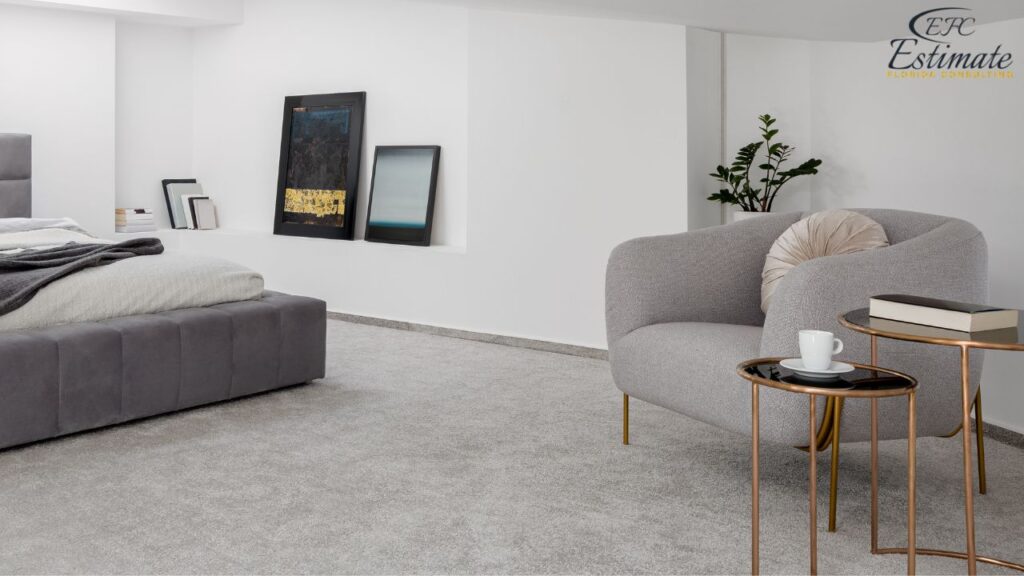
This added layer of protection can significantly extend the life of your carpet, saving you money in the long run by reducing maintenance costs and preserving the carpet’s visual appeal.
Pros and Cons of Carpet Flooring: Making an Informed Decision
Before finalizing your decision on carpet flooring, it’s important to weigh the pros and cons. Understanding these advantages and disadvantages can help you make a choice that best fits your lifestyle and meets your long-term needs. While carpets offer many benefits, they may not be the ideal choice for every situation, so it’s essential to consider both the positives and negatives carefully. By doing so, you can ensure that your flooring choice aligns with your personal preferences, functional requirements, and overall budget.
Benefits of Carpet Flooring
- Comfort and Warmth: Carpet provides a soft, warm surface that’s comfortable underfoot, making it ideal for cozy spaces like bedrooms and living rooms. The insulating properties of carpet also help to retain heat, reducing energy costs during colder months and making your home feel more inviting. This comfort factor is one of the primary reasons why homeowners choose carpet for areas where relaxation and comfort are a priority, creating a cozy and welcoming atmosphere that enhances the overall living experience.
- Versatile Design Options: Available in a wide array of colors, patterns, and textures, carpets can easily complement any interior design style. Whether you’re aiming for a modern, sleek look or a traditional, warm ambiance, there’s a carpet to match your vision. This versatility makes carpet an excellent choice for homeowners who value both style and functionality, allowing you to create a cohesive and visually appealing space that reflects your personal taste and complements your overall decor.
- Noise Reduction: Carpets help absorb sound, making them a great option for reducing noise in multi-level homes or apartments. This feature is especially beneficial in busy households or shared living spaces, where noise can be a concern. Carpet’s sound-dampening qualities contribute to a quieter, more peaceful environment, enhancing the overall comfort of your home and creating a more relaxing atmosphere. For those living in noisy urban areas or homes with multiple occupants, the noise reduction benefits of carpet can significantly improve the overall living environment, making it more enjoyable for everyone.
Drawbacks of Carpet Flooring
- Maintenance Requirements: Carpets require regular vacuuming and occasional deep cleaning to maintain their appearance and hygiene. While they offer many benefits, the maintenance demands can be higher than other flooring options like hardwood or tile. Regular care is necessary to keep carpets looking their best and to prevent the buildup of dirt, dust, and allergens. For those with busy lifestyles, the maintenance demands of carpet may be a drawback, especially in high-traffic areas where dirt and debris accumulate more quickly. However, with proper care and maintenance, carpets can remain beautiful and functional for many years, providing a comfortable and stylish flooring option for your home.
- Stain Vulnerability: Depending on the material, carpets can be prone to staining, particularly in high-traffic areas. While stain-resistant treatments are available, they are not foolproof, and spills need to be addressed promptly to avoid permanent damage. This makes carpets less ideal for households with young children or pets unless extra precautions are taken. If you’re considering carpet for an area prone to spills, it may be worth investing in a stain-resistant material or a stain protection treatment to minimize potential damage and maintain the carpet’s appearance over time.
- Allergen Accumulation: Carpets can trap allergens such as dust, pollen, and pet dander, which may pose a concern for individuals with allergies or respiratory conditions. Although regular cleaning can help manage this issue, it’s something to consider if anyone in your household is sensitive to allergens. In some cases, hypoallergenic carpet options or alternative flooring types may be more suitable. For those with severe allergies or asthma, hardwood or tile flooring might be a better option, as these surfaces are easier to keep clean and allergen-free. However, if you prefer the warmth and comfort of carpet, there are options available that are specifically designed to minimize allergen buildup, making it possible to enjoy the benefits of carpet without compromising on health and well-being.
Download Template For Carpet Flooring Project Breakdown
- Materials list updated to the zip code
- Fast delivery
- Data base of general contractors and sub-contractors
- Local estimators
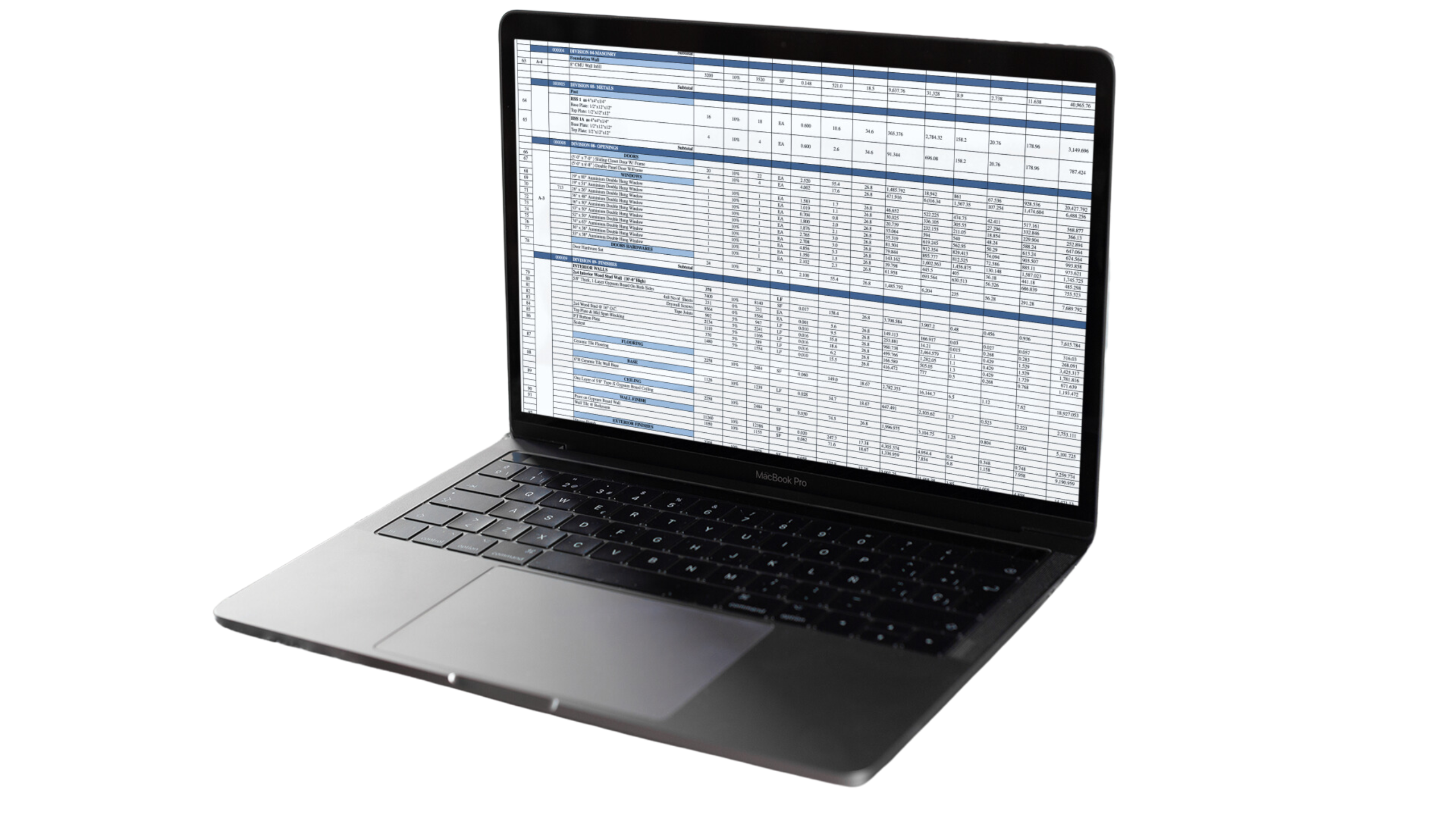
Getting Professional Help: How Estimate Florida Consulting Can Assist?
Estimating the cost of carpet installation can be complex, but you don’t have to do it alone. Estimate Florida Consulting is here to help. Our team of experts provides detailed, accurate estimates that consider all aspects of your project, from selecting the right material and style to planning the installation. Whether you’re upgrading a single room or outfitting an entire building, we offer the insights and guidance you need to make informed decisions and stay within budget. With our expertise, you can feel confident that your project will be completed to the highest standards, resulting in a beautiful, functional, and long-lasting carpet that enhances the overall value of your property.
Why Choose Estimate Florida Consulting?
- Comprehensive Estimates: We take into account every detail of your project, ensuring that nothing is overlooked. From material costs to labor fees, we provide you with a clear and accurate estimate that helps you budget effectively. Our thorough approach ensures that all potential costs are considered, giving you a realistic picture of the financial requirements for your project.
- Expert Guidance: Our team has extensive experience in the flooring industry, allowing us to offer valuable advice on the best materials, styles, and installation methods for your specific needs. We understand that every project is unique, and we work closely with you to ensure that your choices reflect your personal preferences, functional needs, and budget constraints.
- Budget-Friendly Solutions: We understand that every project has a budget, and we work with you to find solutions that meet your financial constraints without compromising on quality. Our goal is to help you achieve the best possible outcome for your carpet installation, ensuring that you get the most value for your investment.
Ready to Start Your Carpet Installation Project?
Let Estimate Florida Consulting assist you with expert cost estimation and project planning. Contact us today to get a detailed estimate tailored to your needs and ensure your project is a success. Our team is dedicated to helping you achieve the best possible outcome for your carpet installation, providing the knowledge and support you need to make your vision a reality. With our help, you can enjoy the comfort and beauty of new carpet flooring, knowing that you’ve made a smart investment in your home or business. Whether you’re looking to enhance a single room or undertake a large-scale renovation, we’re here to guide you every step of the way, ensuring that your project is completed on time, within budget, and to your complete satisfaction.
FAQs
The cost of carpet installation is influenced by several factors, including the type of carpet material, the style of the carpet, the quality of padding, the room size and layout, and the complexity of the installation. Additional costs can arise from carpet removal, moisture barrier installation, and stain protection treatments.
The cost of carpet installation varies depending on the material and complexity of the installation. For instance, nylon carpet can cost between $3.00 and $7.00 per square foot, with additional costs for padding and installation. A standard installation in a 200 sq.ft. room can range from $860 to $1,940, depending on the choices made for materials and labor.
- Nylon: Durable and stain-resistant, ideal for high-traffic areas, costing $3.00 – $7.00 per sq.ft.
- Polyester: Soft and vibrant, suitable for residential spaces, costing $2.00 – $5.00 per sq.ft.
- Wool: Luxurious and natural, best for formal areas, costing $5.00 – $15.00 per sq.ft.
- Olefin (Polypropylene): Moisture-resistant and affordable, ideal for basements, costing $1.50 – $3.50 per sq.ft.
- Triexta: A blend of durability and softness, suitable for various applications, costing $3.50 – $8.00 per sq.ft.
Carpet style influences both the look and cost of your installation:
- Cut Pile: Soft and versatile, costs $2.50 – $6.00 per sq.ft.
- Loop Pile: Durable, best for high-traffic areas, costs $3.00 – $7.50 per sq.ft.
- Cut and Loop: Offers patterned designs, costs $4.00 – $8.00 per sq.ft.
- Berber: Textured and casual, costs $2.50 – $5.50 per sq.ft.
- Saxony: Plush and luxurious, costs $3.50 – $8.00 per sq.ft.
Carpet padding enhances comfort, insulation, and carpet durability. It absorbs the impact of foot traffic and helps extend the life of the carpet. Costs for padding vary:
- Rebond Padding: Affordable and popular, costs $0.30 – $0.70 per sq.ft.
- Foam Padding: Softer feel, costs $0.50 – $1.00 per sq.ft.
- Rubber Padding: Premium, offers superior comfort and noise reduction, costs $1.50 – $3.00 per sq.ft.
- Memory Foam Padding: Luxury option, costs $1.00 – $2.50 per sq.ft.
Larger rooms require more carpet material and incur higher installation costs. The complexity of the room layout, such as irregular shapes or multiple doorways, can also increase labor costs. For example, carpeting a 200 sq.ft. room with nylon carpet might cost between $1,000 and $2,000, depending on the material and installation complexity.
Google Reviews

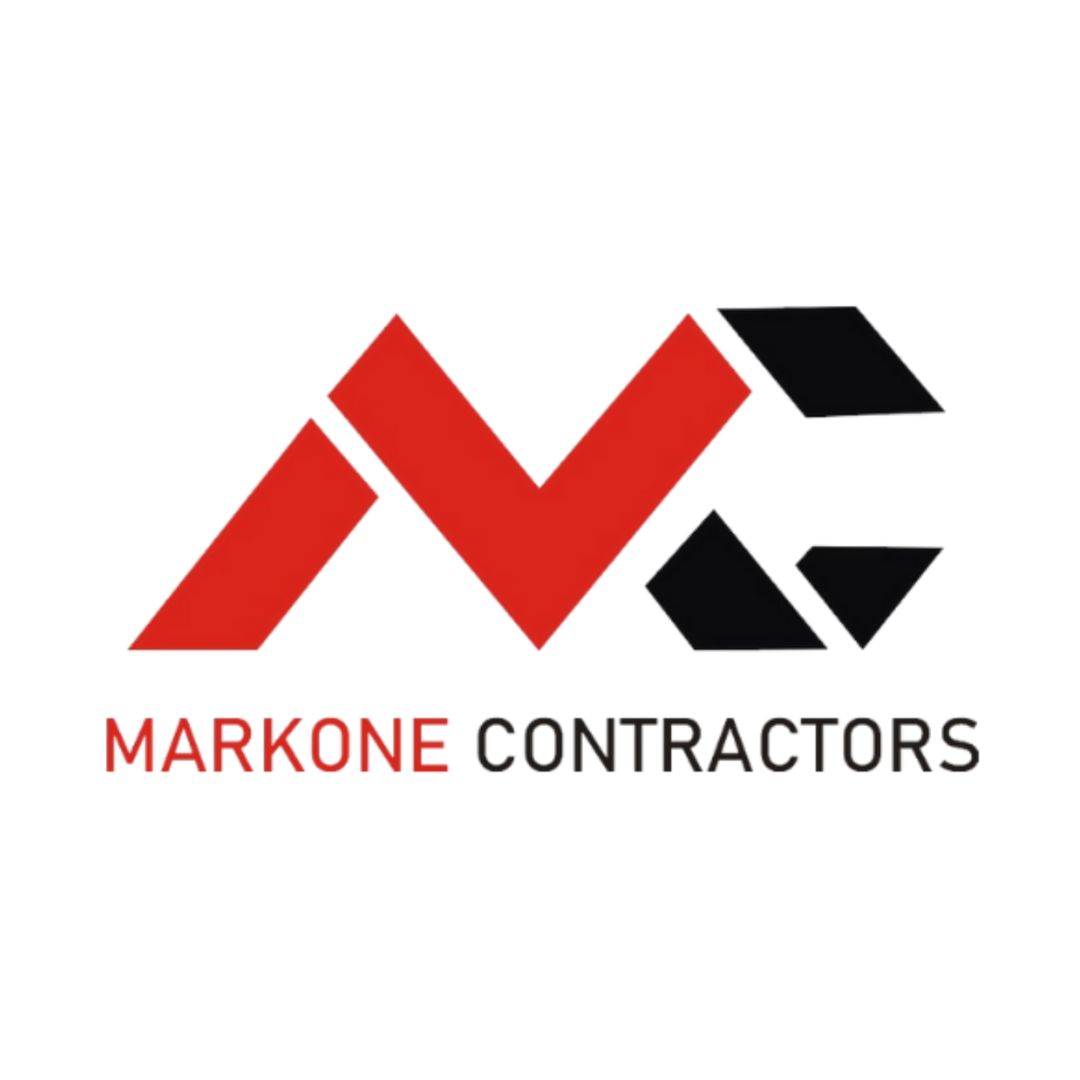
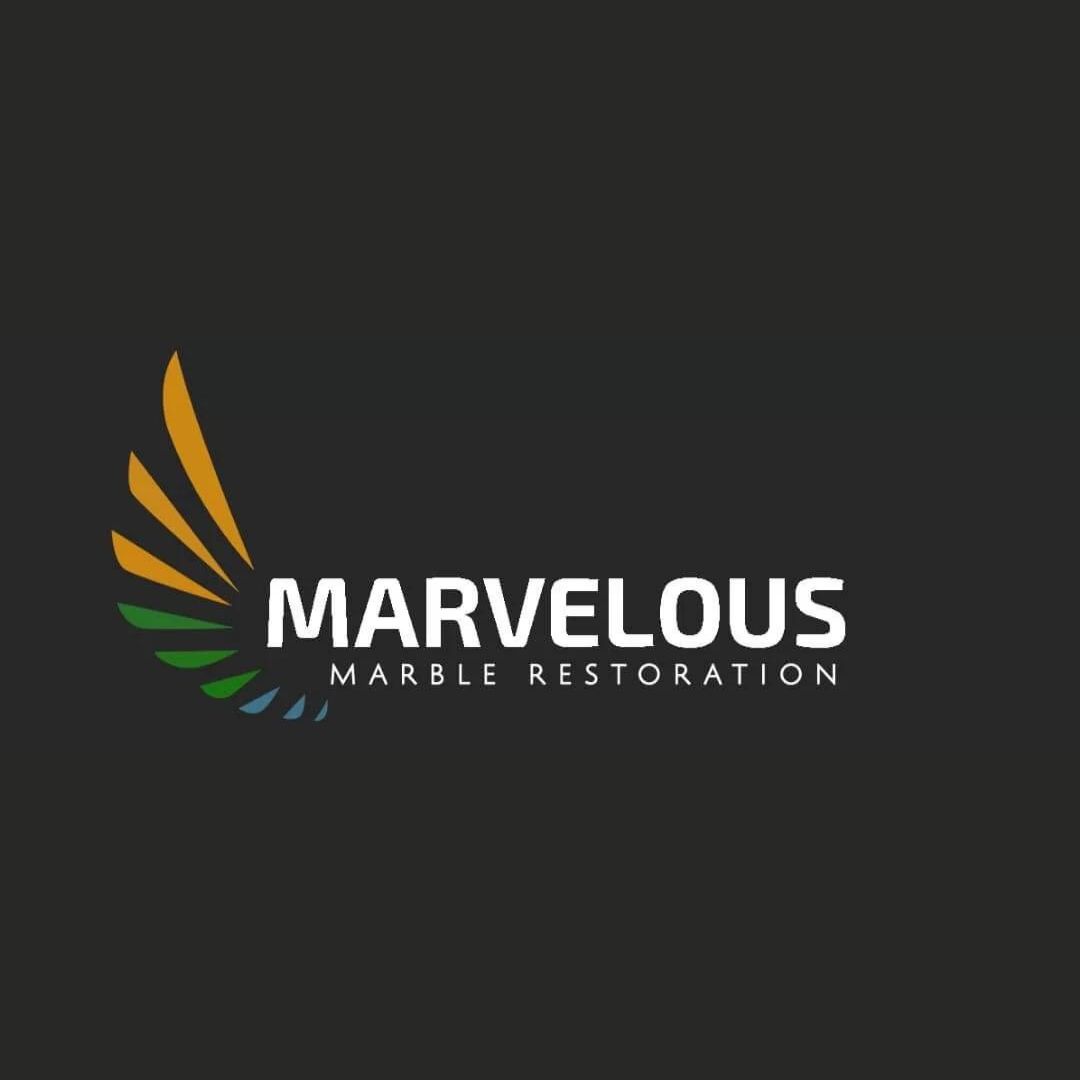
Process To Get Carpet Flooring Cost Estimate Report
Here I am going to share some steps to get carpet flooring cost estimate report.
-
You need to send your plan to us.
You can send us your plan on info@estimatorflorida.com
-
You receive a quote for your project.
Before starting your project, we send you a quote for your service. That quote will have detailed information about your project. Here you will get information about the size, difficulty, complexity and bid date when determining pricing.
-
Get Estimate Report
Our team will takeoff and estimate your project. When we deliver you’ll receive a PDF and an Excel file of your estimate. We can also offer construction lead generation services for the jobs you’d like to pursue further.

